Risk Analysis of Baccarat Non-Negotiable Chip Programs: Confidence Intervals
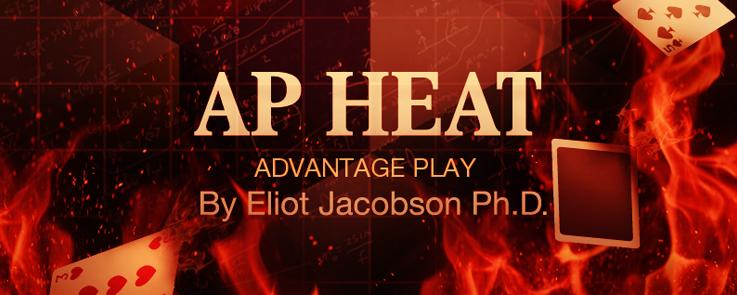
Non-negotiable (NN) rolling chip programs are used by casinos to award cash back rebates to their high-rollers for their play. The rebate is based on returning a fixed percent of all NN chips purchased and lost by the player. In this post, I covered the basic mathematics of NN programs, including computing the effective house edge for each NN chip used. I also showed how to compute the T-Win for a player based on the exact number of NNs the player used. In this post, I presented a method of risk analysis called the z-Score. This analysis is backwards looking; how likely was a result? The present post considers a forward-looking method of risk analysis called confidence intervals.
To follow along, and for your own use, please download and open this spreadsheet:
Rolling_Chip_Rebate_Confidence_Intervals
In this spreadsheet, I make the following assumptions:
- The player plays only the Player and Banker bets. The player does not make any Tie bets.
- The player makes an equal number of Player and Banker bets.
More accurate versions of this spreadsheet can be made to accommodate any betting style, but that's well-beyond my purpose here. To compute confidence intervals using this spread sheet, the user inputs the NN rebate percentage, the number of NN chips to be played and the denomination of the NN chips.
The following shows an example of input for a top-tier high roller who is getting a NN cash rebate of 1.0%. This example is for a player who uses 500 NN chips, each chip having a $10K denomination.
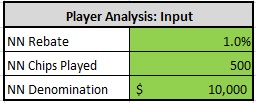
Using the fact that an NN chip is played on average about 2.211 times before it is lost (as I showed in this post), it would take on average about 1,105 hands to wash (lose) these chips. At 40 hands per hour in a squeeze game, it would take about 27.6 hours, on average, to wash these chips. The way Asians devour baccarat, a player could easily achieve this many hours at the table over a long weekend.
The question that confidence intervals answers is: what is a reasonable range of final results for this player at the end of his trip?
To make this precise, the word “reasonable” is replaced with various percentages. So, for example, with “90% confidence intervals,” the word “reasonable” is replaced with “90% of the time.” We then ask the question, what range of final results do we expect this player to fall into on 9 out of 10 trips he takes? It follows that 1 out 10 trips our player will fall outside this range, which means that 1 out of 20 trips his results will fall below the interval and 1 out of 20 trips his results will fall above the interval.
For the player in the example above (rebate = 1%, 500 NNs used, $10,000 denomination, 1% rebate on NNs), the 90% confidence interval is roughly given by:
- Lower 90% confidence = casino winning $590,000
- Upper 90% confidence = player winning $440,000
In other words, 9 out of 10 trips the player’s results should fall somewhere between losing $590K and winning $440K. Hence, 1 out of 20 trips (on average) this player will lose more than $590K. Likewise, 1 out of 20 trips (on average) this player will win more than $440K.
A different perspective on these numbers is that if 2000 players visit the casino and each uses 500 NN chips of denomination $10,000, and each is getting the same 1% cash rebate on the NNs he uses, then we would expect (on average) about 100 such players to lose $590K (or more) and 100 of these players to win $440K (or more). We expect the remaining 1800 of these 2000 players (on average) to have results between these two values.
The following table shows the exact lower and upper limits for the 90%, 95%, 99% and 99.9% confidence intervals:
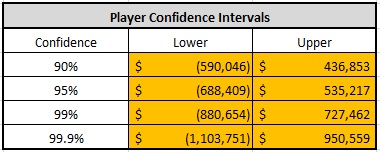
By reference to the bottom row of this table, for the player described above playing 500 NNs, then 99.9% of the time his result should be between losing about $1.104 million and winning about $951 thousand.
The other perspective on the 99.9% confidence range is to consider 2000 players of the type described above. On average, 1998 of these 2000 players will end up between the 99.9% lower and upper limits, that is, between losing $1.104 million and winning $951 thousand. One player in 2000 (on average) should lose more than $1.104 million just by chance. Likewise, one player in 2000 (on average) should win more than $951 thousand, just by chance.
To explain how confidence intervals are computed, let’s take a closer look at the 90% case. The upper and lower limits are derived by consideration of the bell curve. We are looking for the region of the bell curve centered about the middle of the curve that corresponds to 90% of its total area. The following picture illustrates this region:
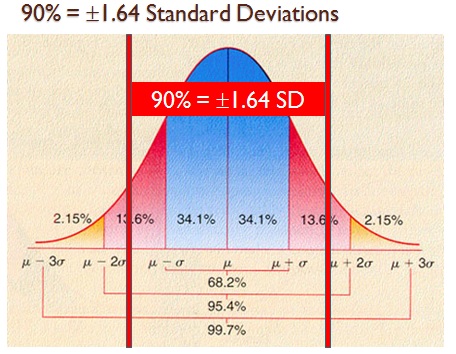
With reference to casino gaming, the middle point (represented by the Greek letter μ for “mean”) represents the player’s theoretical loss to the casino. It is a negative number, because the player lost. The standard deviation (represented by the Greek letter σ) is simply the standard deviation associated with playing the game using however many NNs the player played.
From this picture, we see that 90% of the curve is within 1.64 standard deviations of the mean (more precisely, 1.644853627 standard deviations). The lower an upper limits for the 90% confidence intervals are obtained using these formulas:
- Lower limit of 90% confidence = μ - 1.64σ
- Upper limit of 90% confidence = μ + 1.64σ
To be able to compute the confidence intervals, we need to determine the expected loss μ and the standard deviation σ for a player who plays and uses 500 NNs of denomination $10,000 under a 1.0% cash rebate program. To do this, we make use of the combinatorial analysis for baccarat played with NN chips (once again, see this post). Here it is:
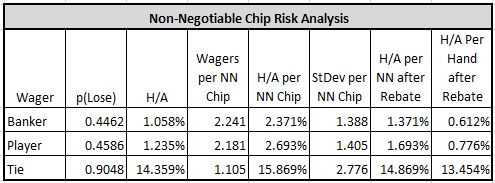
From this data, we see that the house edge per NN chip, with a player who is splitting his wagers evenly between Banker and Player bets, with a 1.0% rebate, is approximately
(1.371% + 1.693%)/2 = 1.532%.
Since this player above is using $10,000 NN chips, the player is losing $153.20 on average per NN chip. Playing 500 chips yields a theoretical loss to the player for the trip of roughly
μ = 500 x -$153.20 = -$76,600.
The standard deviation per NN chip, for a player who is splitting his wagers evenly between Player and Banker bets is approximately
sqrt((1.388^2 + 1.405^2)/2) = 1.396.
Playing 500 chips, each of denomination $10,000, yields a standard deviation for the trip of roughly
σ = sqrt(500) x $10,000 x 1.396 = $312,150.
It follows that the upper and lower limits for the 90% confidence interval are approximately (with some round-off errors),
- Lower = (-$76,600) – (1.64) x ($312,150) = -$590,000
- Upper = (-$76,600) + (1.64) x ($312,150) = +$435,000
I perform the calculations of the player loss and standard deviation with much greater accuracy in the spread sheet provided with this post. Those more accurate values are the ones that appear in the “Player Confidence Intervals” image given above.
The following slide show illustrates the number of standard deviations used for the 90%, 95%, 99% and 99.9% confidence intervals.
What does that 1-in-2000 player who won more than $951 thousand think about his skill level at the game of baccarat? You’ve got to think that he views himself as knowing something about how to bet at the game, even though he can’t tell you what that thing is. Probably his friends view him the same way, and want to bet with him the next time they play together. The player may even post to Internet message boards, boasting about how "good" he is. He may write a small book or magazine article explaining his non-existent system. As Penn Jillette said, “luck is probability taken personally.” This is nowhere more evident than with high-rollers who win at baccarat.
Conversely, what does the casino think about this 1-in-2000 player who won more than $951 thousand? This player has to exist. There is nothing that can be done to prevent winners like this occurring with approximately a 1-in-2000 frequency. Casinos do not have the power to overcome the physical laws of the universe, no matter how much they will it to be so. Casinos that aren’t well versed in risk analysis frequently overreact to winning players.
Knowledge is good, no matter the side of the table you choose to play.


